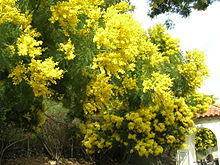Acacia decurrens
| Acacia decurrens | |
|---|---|
 |
|
| Scientific classification | |
| Kingdom: | Plantae |
| (unranked): | Angiosperms |
| (unranked): | Eudicots |
| (unranked): | Rosids |
| Order: | Fabales |
| Family: | Fabaceae |
| Genus: | Acacia |
| Species: | A. decurrens |
| Binomial name | |
|
Acacia decurrens Willd. |
|
| Synonyms | |
Acacia decurrens, commonly known as black wattle or early green wattle, is a perennial tree or shrub native to eastern New South Wales, including Sydney, the Greater Blue Mountains Area, the Hunter Region, and south west to the Australian Capital Territory. It grows to a height of 2–15 m (7–50 ft) and it flowers from July to September.
Cultivated throughout Australia and in many other countries, Acacia decurrens has naturalised in most Australian states and in Africa, the Americas, Europe, New Zealand and the Pacific, the Indian Ocean area, and Japan.
Acacia decurrens is a fast-growing tree, reaching anywhere from 2 to 15 m (7–50 ft) high. The bark is brown to dark grey colour and smooth to deeply fissured longitudinally with conspicuous intermodal flange marks. The branchlets have longitudinal ridges running along them that are unique to the species. Young foliage tips are yellow. .
Alternately arranged leaves with dark green on both side. Stipules are either small or none. Base of petiole swollen to form the pulvinus. Leaf blade is bipinnate. Rachis is 20–120 mm long, angular and hairless. 15-45 pairs of widely spaced small leaflets (pinnules) are connected each other and 5–15 mm long by 0.4–1 mm wide, straight, parallel sided, pointed tip, tapering base, shiny and hairless or rarely sparsely hairy leaves.
The small yellow or golden-yellow flowers are very cottony in appearance and are densely attached to the stems in each head with 5–7 mm long and 60–110 mm long axillary raceme or terminal panicle. They are bisexual and fragrant. The flowers have five petals and sepals and numerous conspicuous stamens. Ovary is superior and has only one carpel with numerous ovules.
Flowering is followed by the seed pods, which are ripe over November to January.
Dark brown or reddish brown to black colour of the seed are located inside of parallel sided, flattish, smooth pod. They are 20–105 mm long by 4-8.5 mm wide with edges. Seed opens by two valves. Pods are initially hairy but they become hairless when they grow.
...
Wikipedia
